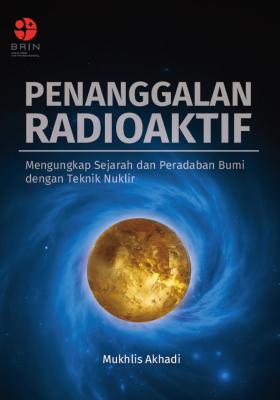Penanggalan Radioaktif: Mengungkap Sejarah dan Peradaban Bumi dengan Teknik Nuklir
Keywords:
Radioaktif , Teknik Nuklir , Peradaban Bumi , Fisika , Sejarah BumiSynopsis
Buku ini mengupas pemanfaatan radionuklida alamiah untuk penanggalan radioaktif (radioactive dating). Di dalamnya dibahas secara komprehensif hal-hal yang berkaitan dengan radionuklida primordial dan radionuklida kosmogenik. Dibahas pula hal-hal yang terkait dengan teknik penanggalan dengan mengandalkan kedua jenis radionuklida tersebut baik di bidang geologi maupun arkeologi, disertai dengan contoh-contoh prestasi konkrit yang telah dihasilkan dari pemanfaatan teknik tersebut.
Selesai membaca buku ini diharapkan akan muncul gambaran obyektif tentang peran penting teknologi nuklir dalam studi geologi dan arkeologi. Aplikasi teknologi nuklir telah memberi sumbangan yang nyata bagi perkembangan ilmu pengetahuan di kedua bidang tersebut. Selamat membaca!
Downloads
References
A brief history of radiation. (1995). Los Alamos Science Number 23 (116–123).
A’zami, M. M. (2003). The history of the Qur’anic text from revelation to compilation: a comparative study with the Old and New Testaments. UK Islamic Academy.
Amirudin, A. (2009). Kimia inti dan radiokimia. PDIN-BATAN.
Anatole, A., Klyosov, A. A., & Rozhanskii, I. L. (2012). Re-examining the “Out of Africa” theory and the origin of Europeoids (Caucasoids) in light of DNA genealogy. Advances in Anthropology, 2(2), 80–86.
Anderson, D. L. (1989). Theory of the earth. Blackwell Scientific Publications.
Arnikar, H.J. (1996). Essentials of nuclear chemistry. (4th edition). New Age International (P) Limited Publishers.
Aryawardhana, W. (1996). Radioekologi. Penerbit Andi.
Asteroids and dinosaurs: unexpected twists and an unfinished story. (2007). The University of California Museum of Palaeontology and the Regents of the University of California.
Bacon, D. H. & Seymour, P. A. (2003). Mechanical history of the universe. Philip Wilson Publishing Ltd.
Badan Tenaga Nuklir Nasional (t.t). Glosarium iptek nuklir. Diakses pada 10 April, 2016, dari http://www.batan.go.id/index.php/id/glosarium2.
Balchin, J. (2012). Quantum leaps: 100 ilmuwan besar paling berpengaruh di dunia. (S.Damayanti, Penerj.). Ufuk Press.
Birch, B. (1993). Marie Curie (A. T. K. Widodo, Penerj.), P.T. Gramedia Pustaka Utama.
Birmingham Qur’an manuscript dated among the oldest in the world. (2015, 22 July). University of Birmingham http://www.birmingham.ac.uk/news/latest/2015/07/quran-manuscript-22-07-15.aspx,
Blyth, F. G. H. & de Freitas, M. H. (1984). Geology for engineers. Elsevier Butterworth-Heinemann Linacre House.
Branley, F.M. (1997). Bumi. Dalam S. C. Bernard, G. B. Lynn, & J. J. Joseph (Ed.). Ilmu Pengetahuan Populer Vol. 1 (97–105). Grolier International Inc.; P.T. Widyadara.
Chember, H. & Johnson, T.E. (2009). Introduction of health physics. (4th edition). Pergamon Press.
Chiappini, C. (2001). The formation and evolution of the Milky Way. American Scientist, 89(6), 506–515.
Cohen, B. L. (1982). Concept of Nuclear Physics. Tata McGraw-Hill Publishing Company Ltd.
Cook, J. E. (1986). Environmental radiation and radioactivity. Australian School of Nuclear Technology.
Cosmic background explorer. (2001). Encyclopedia of Astronomy and Astrophysics. Nature Publishing Group; Institute of Physics Publishing.
Cosmic rays. (2003). Spatium; No. 11. International Space Science Institute.
Cross, A., Jaireth, S., Huston, D., Skirrow, R. (2012, June). Dating Australia’s uranium deposits: Chemical dating of uraninite to encourage explorers. Ausgeo News; Issue 106. https://ga.gov.au/ausgeonews/ausdeonews201205/uranium.isp.
Darmawan, D. (2017, 20 Maret). Lecture notes: astrofisika (FIS-239), Program Studi Fisika FMIPA Universitas Negeri Yogyakarta.
Darvill, C. M. (2013). Cosmogenic nuclide analysis. Dalam Geomorphological Techniques (1–25), British Society for Geomorphology.
Debaene, G. (2003). Uranium-series dating of Marly sediments: application to Jaroszów Fossil Lake (SW Poland). Geochronometria: Journal on Methods and Applications of Absolute Chronology, 22, 15–26.
Delgado, A. (1995). Basic concepts of thermoluminescence. Dalam M. Oberhofer (Ed.). Personnal Thermoluminescence Dosimetry (47–69). Report EUR 16 277: 47.
Dimitrova, C. (2008). Pottery production in ancient Greece. Dalam R. I. Kostov, B. Gaydarska, B., & M. Gurova (Eds.). Geoarcheology and Archaeomineralogy (108-110). Proceedings of the International Conference.
Dunai, T. J. (2010). Cosmogenic nuclides: principles, concepts and applications in the earth surface sciences. Cambridge University Press.
Field, G. B. (1997). Asal mula jagad raya. Dalam S. C. Bernard, G. B. Lynn, & J. J. Joseph (Ed.). Ilmu Pengetahuan Populer Vol. 1 (13–16). Grolier International Inc.; P.T. Widyadara.
Friedlander, G., Kennedy, J. W., & Macias, E. S. (1981). Nuclear and radiochemistry. (3rd ed.). John Wiley & Sons.
Fujitaka, K. (t.t.). Cosmic radiation. NIRS, 4-9-1 Anagawa, Inaga, Chiba 263-8555, Japan.
Furetta, C. (1995). TL materials and their properties. Dalam M. Oberhofer (Ed.), Personnal Thermoluminescence Dosimetry (71–106). Report EUR 16 277 EN.
Gautreau, R. & Savin, W. (1995). Fisika Modern (H. J. Wopspakrik, Penerj). Penerbit Erlangga.
Glosarium llmu dan teknologi nuklir. (2009). Cetakan III. BATAN.
Goldstein, B. R. (2002). Copernicus and the origin of his heliocentric system. Journal for the History of Astronomy, 33(3), 219–235.
Gradstein, F. M., Ogg, J. G., & Van Kranendonk, M. (2008). On the geologic time scale 2008. Newsletters in Stratigraphy, 43(1), 5. https://www.nhm2.uio.no/norges/TimeScale2008.pdf
Hajdas, I. (2008). Radiokarbon dating and its applications in quaternary studies. Eiszeitalter and Gegenwart Quaternary Science Journal, 57(1–2), 2–24.
Halliday, D. & Resnic, R. (1990). Fisika modern (P. Silaban, Penerj.). Penerbit Erlangga.
Haramundanis, K. (1997). Penelaahan tentang jagad raya. Dalam S. C. Bernard, G. B. Lynn, & J. J. Joseph (Ed.). Ilmu Pengetahuan Populer Vol. 1 (1–12). Grolier International Inc.; P.T. Widyadara.
Hipkin, J. & Payter, R. A. (1991). Radiation exposures to the workplaces from natural occuring radioactivity in industrial processes. Radiation Protection Dosimmetry. 36(2–4): 97–100.
Historic England. (2015). Archaeological and historic pottery production sites. Guidelines for best practice. Historic England.
Hufton, A. P. (ED.). (1984). Practical aspect of thermoluminescence dosimetry. The Hospital Physicists’ Association.
Ingpen, R. & Wilkinson, P. (1995). Encyclopedia of ideas that changed the world, the greatest discoveries and inventions of human history. A Dragon’s World Book.
Kaplan, I. (1979). Nuclear physics (2nd edition). Addison-Wesley Publishing Company.
Knief, R. A. (1981). Nuclear energy technology. Hemisphere Publishing Corporation.
Krane, K. S. (1992). Fisika modern (H. J. Wospakrik & S. Niksolihin, Penerj.). Cetakan I. Penerbit Universitas Indonesia.
Krymsky, R. S., Macambira, M. J. B., Lafon, J. M., & Estumano, G. S. (2007). Uranium-lead dating method at the Pará-Iso Isotope Geology Laboratory, UFPA, Belém - Brazil. Annals of the Brazilian Academy of Sciences, 79(1), 115–128.
Libby, W. F. (1960). Radiocarbon dating nobel lecture. The Nobel Prize. https://www.nobelprize.org/prizes/chemistry/1960/libby/lecture.
Libby, W. F. (1997). Pendataan radiocarbon. Dalam S. C. Bernard, G. B. Lynn, & J. J. Joseph (Ed.). Ilmu Pengetahuan Populer Vol. 10 (52–57). Grolier International Inc.; P.T. Widyadara.
Libby, W. F. (t.t.). History of radiocarbon dating. Department of Chemistry and Institute of Geophysics, University of California.
Lobeck, A. K. (1997). Gua. Dalam S. C. Bernard, G. B. Lynn, & J. J. Joseph (Ed.). Ilmu Pengetahuan Populer Vol. 3 (2–12). Grolier International Inc.; P.T. Widyadara.
Mahesh, K. (1989). Thermoluminescence in solids and its applications. Nuclear Technology Publishing.
Martin, A. & Harbinson, S. A. (1986). An introduction to radiation protection. (3rd edition). Chapman and Hall.
McKinlay. (1981). Thermoluminescence dosimetry (medical physics handbooks 5). Adam Hilger Ltd.
Newman, W. L. (t.t.). Geologic time. U.S. Geological Survey. Information Services Box 25286.
Nieto, J. A. (1990). Luminescence dosimetry: theory and applications. Derechos Reselvados.
Oldest noodles unearthed in China. (2015, October 12). http://news.bbc.uk/go/pr/fr/-/1/hi/sci/tech/4335160.stm.
Pacton, M., Breitenbach, S. F. M., & Lechleitner, F. A. (2013). The role of microorganisms in the formation of a stalactite in Botovskaya cave, Siberia – Paleoenvironmental Implications. Biogeosciences 10, 6115–6130.
Parkinson, C. L., Ward, A., & King, M.D. (2006). Earth science reference handbook: a guide to NASA’s earth science program and earth observing satellite missions. National Aeronautics and Space Administration, 277, 805.
Penelaahan tentang bumi. (1997). Dalam S. C. Bernard, G. B. Lynn, & J. J. Joseph (Ed.). Ilmu Pengetahuan Populer Vol. 2 (204–211). Grolier International Inc.; P.T. Widyadara.
Quamrul, A. Q. & Galor, O. (2012). The “Out of Africa” Hypothesis, Human Genetic Diversity, and Comparative Economic Development. IZA Discussion Paper No. 6330. http://ftp.iza.org/dp6330.pdf.
Quirke, T. T. (1997). Lapisan kerak bumi. Dalam S. C. Bernard, G. B. Lynn, & J. J. Joseph (Ed.). Ilmu Pengetahuan Populer Vol. 2 (212–220). Grolier International Inc.; P.T. Widyadara.
Radiasi dalam bahasa sehari-hari. (1996). BATAN.
Reynolds, G. S. (Ed.). New perspectives on the qur’an: the Qur’an in its historical context 2. Routledge.
Rozamski, K. & Froehlich, K. (1996). Radioactivity and earth Sciences: understanding the natural environment. IAEA Bulletin, 38(2), 9–15.
Santoso, R. S. I. (1977). Capita selecta sejarah perkembangan ilmu pengetahuan. Sinar Hudaya.
Satrio, Rokhma, N. S., Abidin, Z., Syafalni, Paston, & Djiono (2003). Penentuan umur stalagmite gua Njirak Tenggalek Jawa Timur dengan 14C. Risalah Pertemuan Ilmiah Penelitian dan Pengembangan Aplikasi Isotop dan Radiasi; P3TIR-BATAN, 193–197.
Scharmann, A. (1995). Thermoluminescence dosimetry – historical review, status quo and perspective. Dalam M. Oberhofer. (Ed.). Personnal Thermoluminescence Dosimetry (1–19). Report EUR 16 277 EN.
Setiawan, S. (1994). Gempita tarian kosmos. Penerbit Andi Offset.
Skala waktu geologi. (1997). Dalam S. C. Bernard, G. B. Lynn, & J. J. Joseph (Ed.). Ilmu Pengetahuan Populer Vol. 3 (187–192). Grolier International Inc.; P.T. Widyadara.
Standen, A. (1997). Daftar berkala. Dalam S. C. Bernard, G. B. Lynn, & J. J. Joseph (Ed.). Ilmu Pengetahuan Populer Vol. 4 (139–161). Grolier International Inc.; P.T. Widyadara.
Supelli, K. (2017, 20 Maret). Kosmologi: mengenali alam semesta. https://arusbawah20.wordpress.com/2010/07/24/kosmologi-mengenali-alam-semesta.
Suprapto. (1991). Granit sumber uranium. Buletin BATAN, Th. XII(3), 14–18.
Sutton, C. (1987). Ninety years around the atom. New Scientist 40(2), 49–53.
Taylor, J. R. & Zafiratos, C. D. (1991) Modern physics for scientist and engineers. Prentice Hall.
Taylor, R. E. (2005). Radiocarbon dating: the continuing revolution. Evolusionary Anthropology, Issues, News and Reviews, 4(5), 169–181.
Torsvik, T. H. & Cocks, L. R. M. (2013). Gondwana from top to base in space and time. Gondwana Research 24(3–4), 999–1030.
Tsoulfanidis, N. (1983). Measurement and detection of radiation. Hemisphere Publishing Corporation.
United Nations Scientific Committee on the Effect of Atomic Radiations. Sources and effects of ionizing radiation (UNSCEAR 2000 Reports to General Assembly). Volume 1: Sources. United Nations.
Uranium/lead dating provides most accurate date yet for earth’s largest extinction (2004, 16 September). Phys Org. https://phys.org/news/2004-09-uraniumlead-dating-accurate-date-earth.html.
Walker, F. W., Miller. D. G., & Feiner, F. (1989). Nuclides and isotopes. (14th edition). GE Nuclear Energy.
White, O. R. (1997). Matahari. Dalam S. C. Bernard, G. B. Lynn, & J. J. Joseph (Ed.). Ilmu Pengetahuan Populer Vol. 1 (65–78). Grolier International Inc.; P.T. Widyadara.
White, W. B. (2013). Cave sediments and paleoclimate. Journal of Cave and Karst Studies, 69(1), 76–93.
Wilopo, A. C. (Ed.). (2002). Seabad pemenang hadiah nobel fisika. Abdi Tandur.
Wilson, C. V. (1997). Sinar-sinar kosmos. Dalam S. C. Bernard, G. B. Lynn, & J. J. Joseph (Ed.). Ilmu Pengetahuan Populer Vol. 1 (223–229). Grolier International Inc.; P.T. Widyadara.
Wilson, J. T. (1997). Lempeng tektonik. Dalam S. C. Bernard, G. B. Lynn, & J. J. Joseph (Ed.). Ilmu Pengetahuan Populer Vol. 2 (221–229). Grolier International Inc.; P.T. Widyadara.
Wospakrik, H. J. (2005). Dari atomos hingga quark. Penerbit Universitas Atma Jaya; Kepustakaan Populer Gramedia.
Yigal, S. H.(Ed.). (1983). Thermoluminescence and thermoluminescent dosimetry volume III. CRC Press Inc.
Young, H. D. & Freedman, R. A. (1998). University physics (9th edition). Addison-Wesley Publishing Company.

Downloads
Published
Categories
License

This work is licensed under a Creative Commons Attribution-NonCommercial-ShareAlike 4.0 International License.






























